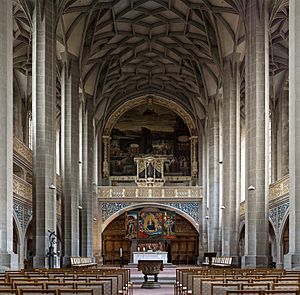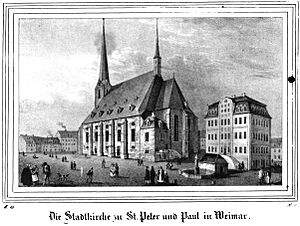Christen, ätzet diesen Tag, BWV 63 facts for kids
Quick facts for kids Christen, ätzet diesen Tag |
|
|---|---|
| Christmas cantata | |

Liebfrauenkirche, Halle
|
|
| Performed |
|
| Movements | 7 |
| Vocal | SATB choir and solo |
| Instrumental |
|

Christen, ätzet diesen Tag (which means "Christians, engrave this day") is a special piece of music called a church cantata. It was written by the famous composer Johann Sebastian Bach. This cantata is also known as BWV 63.
Bach likely wrote this Christmas cantata around 1713 for the First Day of Christmas. It might have been for the Liebfrauenkirche in Halle. He performed it again on December 25, 1723, in Leipzig. This was his first Christmas as the music director (called Thomaskantor) in Leipzig.
Contents
A Christmas Cantata by Bach
This cantata is one of Bach's earliest Christmas pieces that we still have today. He might have composed it in Weimar as early as 1713. The words of the cantata suggest it was meant for the Liebfrauenkirche in Halle. Bach had applied to be the organist there in 1713.
The person who wrote the words for the cantata might have been Johann Michael Heineccius. He was a pastor at that church. He also wrote words for other cantatas by Bach. This pastor supported Bach's application for the organist job.
Why So Many Instruments?
A music expert named Christoph Wolff noticed that this cantata uses many instruments. It has four trumpets, timpani (drums), and three oboes, plus strings. This was a very large group of musicians for Bach's time. It was much bigger than what was usually used in Weimar.
This suggests the piece was not for a small church. It was likely for a grander performance. Some experts think the first performance might have been in Weimar. It could have been in the church of St. Peter und Paul. Musicians from both the duke's orchestra and the town might have played together.
The Story Behind the Music
For Christmas Day, churches would read certain Bible passages. These included stories about God's mercy and the birth of Jesus. The cantata's writer created a text that was very balanced. It had a central speaking part (recitative). This part was surrounded by two duets, then two more speaking parts, and finally two big chorus sections.
Most of Bach's later cantatas end with a simple church hymn (a chorale). But this one doesn't. This makes some people wonder if it was first written for a non-religious event.
Later Performances
The cantata was performed again in Halle in 1717. This was to celebrate 200 years since the start of the Protestant Reformation. Another expert, Philipp Spitta, thought the cantata was written for Leipzig in 1723. Bach performed it on his first Christmas there. He chose this impressive piece instead of writing a new one for that day.
This cantata needed the largest group of musicians Bach had used since starting his job in Leipzig. It required four trumpets, timpani, and three oboes. Bach performed this cantata in Leipzig at least one more time, possibly in 1729.
Instruments and Sections
This cantata has seven parts, called movements. It's played by four solo singers: a soprano (high female voice), an alto (lower female voice), a tenor (high male voice), and a bass (low male voice). There's also a four-part choir.
The instruments include four trumpets, timpani (kettledrums), three oboes, a bassoon, two violins, a viola, and a continuo (a group of instruments that play the bass line and harmonies). In a later version, an organ was also used.
Here are the seven parts of the cantata:
- 1. Chorus: Christen, ätzet diesen Tag (Christians, engrave this day)
- 2. Recitative (alto): Oh, selger Tag! o ungemeines Heute (Oh, blessed day! oh unusual today)
- 3. Aria (soprano, bass): Gott, du hast es wohl gefüget (God, you have arranged it well)
- 4. Recitative (tenor): So kehret sich nun heut (So now today turns)
- 5. Aria (alto, tenor): Ruft und fleht den Himmel an (Call and plead to heaven)
- 6. Recitative (bass): Verdoppelt euch demnach (Therefore, double yourselves)
- 7. Chorus: Höchster, schau in Gnaden an (Highest, look with grace)
The Music Itself
The cantata sounds very festive and grand. But it doesn't have the usual Christmas sounds. There are no lullabies, songs for shepherds, or angels' songs. It also doesn't have a typical Christmas carol or hymn.
The words of the cantata are very balanced, and the music matches this. The speaking parts (recitatives) sometimes sound more like singing (arioso). This was common in Bach's music during that time. The chorus parts often repeat sections, but with different middle parts. This is similar to an older style of music called a motet.
Special Musical Moments
The first speaking part for the alto singer is special. It describes a struggle to break free from "Satan's slavish chains." Bach's cantata also has two duets, which are rare in his works. These duets show a feeling of shared happiness. The second duet is like a minuet dance. It matches the words, "Come, you Christians, come to dance."
Instead of a hymn, the cantata ends with a very energetic chorus. The trumpets start with grand fanfares. Then the voices sing a fanfare, praising the "Highest." After that, the voices and instruments join in a complex musical chase called a fugue. This expresses thanks from the faithful.
The middle part of this final chorus has another fugue. It ends with a very intense moment. The music slows down, and the harmony becomes sad and dramatic. This part describes the deep sadness at the thought of evil. Then, the first part of the chorus repeats, ending the cantata with its original joyful and celebratory sounds.
In one of his later performances, Bach changed the music for one of the oboes in the third movement. He wrote a new part for the organ instead.
Recordings
Many groups have recorded this cantata. Here are some of them:
- J. S. Bach: Cantata BWV 63, Michael Gielen, Wiener Kammerchor, Vienna State Opera Orchestra, 1952
- J. S. Bach: Cantata 63, Christen, ätzet diesen Tag, and the Magnificat, Günther Ramin, Thomanerchor, Gewandhausorchester, 1953
- Die Bach Kantate Vol. 61, Helmuth Rilling, Gächinger Kantorei, Bach-Collegium Stuttgart, 1971
- Bach Cantatas Vol. 1 – Advent and Christmas, Karl Richter, Münchener Bach-Chor, Münchener Bach-Orchester, 1972
- J. S. Bach: Das Kantatenwerk – Complete Cantatas Vol. 16, Nikolaus Harnoncourt, Tölzer Knabenchor, Concentus Musicus Wien, 1976
- J. S. Bach: Complete Cantatas Vol. 3, Ton Koopman, Amsterdam Baroque Orchestra & Choir, 1995
- J. S. Bach: Cantatas Vol. 7, Masaaki Suzuki, Bach Collegium Japan, 1997
- J. S. Bach: Christmas Cantatas, John Eliot Gardiner, Monteverdi Choir, English Baroque Soloists, 1998
- Bach Edition Vol. 18 – Cantatas Vol. 9, Pieter Jan Leusink, Holland Boys Choir, Netherlands Bach Collegium, 2000
- J. S. Bach: Christmas Cantatas from Leipzig, Philippe Herreweghe, Collegium Vocale Gent, 2002
- Bach: Cantata 63; Mendelssohn: Vom Himmel hoch; Vaughan Williams: The First Nowell, Vladimir Jurowski, London Philharmonic Orchestra and Choir, 2009
- Thomanerchor Leipzig – Das Kirchenjahr mit Bach, Vol. 2: Weihnachten · Christmas – Cantatas BWV 63, 110, 190, Georg Christoph Biller, Thomanerchor, Gewandhausorchester, 2011
See also
 In Spanish: Christen, ätzet diesen Tag, BWV 63 para niños
In Spanish: Christen, ätzet diesen Tag, BWV 63 para niños

